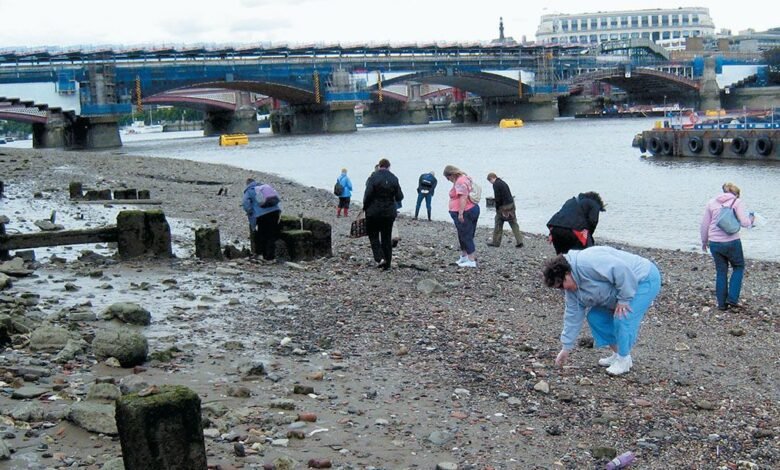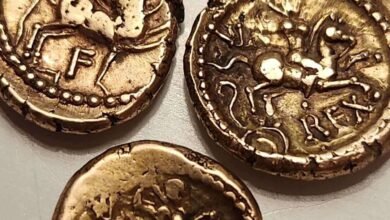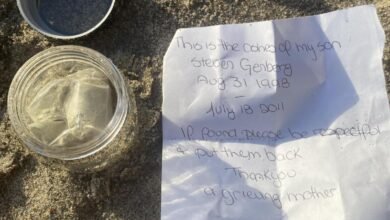Mudlarking on the Thames – treasure hunting in London

Mudlarks lived on the tidal flats of the Thames for 200 years. These days, tidal archeology can be a fun London adventure.
*Originally published January 2012.
OOn a cool summer Sunday, about thirty of us adults and a few children gather outside Mansion House tube station in London. We are waiting for Fiona Haughey, a tidal archaeologist, who will lead us to the banks of the Thames. We have to search for about half a kilometer. If we’re lucky, we’ll find everything from broken pipe stems, horse teeth and unidentifiable shards of glass to Victorian jewelry, Roman coins and Tudor buttons.
Haughey’s best find was a Bronze Age skull that had been trepanned – surgically opened (probably to drive out evil spirits) – and then healed, suggesting the patient survived. It is the oldest evidence of an operation in London and is on display in the British Museum. But she says: “I’m really excited about a piece of Neolithic pottery that has a fingerprint on it. “I’ve found hand axes that go back to the end of the last ice age, 10,000 years ago.” The number of participants in Haughey’s walks is between three and 100 and she carries them out rain, shine or blizzard.
“We’re going to an archaeological site,” explains Haughey, and although she won’t confirm that it’s the largest in the world, as some sources claim, it is definitely the largest in Britain. We are warned about the dangers of rat-borne diseases, given rubber gloves, and led to the river. Along the way we learn why the Roman Londoninium was built between two hills on a tidal estuary and the names of all the bridges. We also learn that the Thames was extremely polluted until the 1950s, when cleanup efforts began, and is now the cleanest estuary in Europe.
“There are now 124 species of vertebrates and invertebrates living in the river, as well as countless plants in the riverbed that cannot be seen. It’s teeming with life. The Environmental Protection Agency calls it a superhighway. Occasionally you will see a cormorant diving down and picking up an eel, throwing it into the air with a little momentum and devouring it like spaghetti. It’s all going on down there. My colleagues at the Environment Agency often do a net operation where they drag a net around and you see a huge diversity of species.”
© MUSEUM OF LONDON
Haughey explains that anyone can search for artifacts along the Thames. Many hobbyists do it regularly. “But if you do it, you should have a permit. English heritage laws can determine which areas you can and cannot work in,” she says. “More importantly, they indicate how much, if any, you can dig. For example, if neither of you can produce a permit for the Thames foreshore, you are not allowed to move dirt at all, and by that I mean scraping it off with your foot or moving things with a nail. You can pick up things, but you can’t move dirt.”
She emphasizes that there are unsafe areas in which to indulge in mud taunts. This particular section, Bankside, is considered safe. Elsewhere, an illegal brotherhood regularly works, digging huge holes and selling their finds – mostly coins – abroad, and it can be dangerous to approach them.
The 2,000-year-old Celtic bronze shield known as the Battersea Shield (left) was dredged from the River Thames in 1857. Treasures from the river belong to the Crown and end up in the Museum of London. JEAN PASCHKE
Haughey says: “If you find something that is considered ‘treasure’ I will take it to the Museum of London. “I will put your name on it, but it is up to the museum to decide what to do with it.”
“Don’t forget,” she adds, “anything that is ‘treasure’ belongs exclusively to Her Majesty until proven otherwise,” and cheerful comments about paying for the royal wedding pass through the group. The Museum of London has case after case of such finds, including ceramics, weapons, buttons and jewelry. The most magnificent of these, the Battersea Shield, is only exhibited as a replica; the original is in the British Museum.
But so-called mudlarking has a darker history. It wasn’t always the domain of happy hobbyists, but rather a necessity to support families. In the 19th century, many poor Londoners made a living by digging objects out of the mud. Men, young women (“tide waitresses”) and children aged between 8 and 15 often visited the banks of the Thames or the River Fleet – once a stream that flowed from Highgate to the Thames, now a sewer. They were “a picture of hardship and misery,” as one 19th-century writer put it. They looked for firewood, rope that could be torn apart and made into tow, coal dropped from barges, iron, tin, bones of drowned animals that could be made into fertilizer, broken glass, copper nails and bolts, rags, and everything else , which it could be sold to a marine store owner. If they were lucky they might earn six pence a day.
Tidal archaeologist Fiona Haughey leads people on mud expeditions that actually help look after the banks of the Thames. A clay pipe stem or a piece of Victorian glass is your likely souvenir. JEAN PASCHKE
Mudlarks wore aprons with deep pockets or carried a bag on a leather shoulder strap and dug through the mud with sticks or felt for treasure with their feet. They were not afraid to walk around stranded coal ships and take some of their cargo or remove copper from a moored barge. Sometimes they ventured into the sewers. You might find a handbag that fell from a pleasure boat, a piece of precious jewelry, a piece of sterling dinnerware, or, like today, an antique relic.
Storms and floods were a source of joy for the mudlarks, as buildings in Clerkenwell tended to be washed away and there was a lot of furniture, household goods, birdcages, keys and toys to be found there. The owners might go out in boats to collect their belongings, but often the mudlarks beat them to it.
Most beachcombers find items washed ashore by the sea, but this beach is different: “Everything came down from the city or was originally here,” Haughey said. “Underneath all of this lie prehistoric land surfaces.” It turns out that the area we will be searching was part of a boat repair yard that operated from the late 18th to early 20th centuries, so there may be many unidentifiable pieces of metal or nails appear.
We descend the stairs to the bank, wading first through what Haughey claims is clean mud, but is in fact very slippery mud. Its low oxygen content helps preserve items. As we search, tiny things appear among the stones and shells – pipe stems, especially because in the 1560s to 1930s, tiny clay pipes were sold packaged with tobacco and thrown away after use.
None of us can find anything worthy of a museum. One woman has a piece of 17th-century salt-glaze pottery, another has an 18th-century pipe stem. A man finds the lid of a red Victorian teapot. I find a piece of blue floral porcelain that Haughey says came from a Victorian dressing table stand, a few unidentifiable pieces of stoneware and metal, and of course pipe stems. We are urged to take only one or two pieces.
After an hour the tide washes us all ashore. Haughey is traveling to Turkey for two months. She leaves us with a parting thought: “I want people to embrace their territory and look after their foreshore. You don’t need powerful archaeologists. You need someone who can do that. They actually need people to look after their foreshore. This is a very good resource and when it’s gone, it’s gone.”
For more informations: www.walks.com
*Originally published January 2012.



